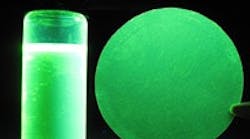Image shows fluorescence of solution (left) and membrane (right) made of a polymer of intrinsic microporosity (PIM-1) under irradiation of ultraviolet (UV) light. The UV irradiation induces oxidation and surface densification of the polymeric molecular sieve membranes. Source: Nature Publishing Group.
New research shows that exposing polymer molecular sieve membranes to ultraviolet (UV) irradiation in the presence of oxygen produces highly permeable and selective membranes for more efficient molecular-level separation, an essential process in everything from water purification to controlling gas emissions.
Published in the journal Nature Communications on May 28, the study finds that short-wavelength UV exposure of the sponge-like polymer membranes in the presence of oxygen allows the formation of ozone within the polymer matrix. This ozone induces oxidation of the polymer and chops longer polymer chains into much shorter segments, increasing the density of its surface.
Controlling this "densification" leads to smaller cavities on the membrane surface and scientists have found they're able to create a greatly enhanced sieve for molecular-level separation; these micro-cavities improve to a significant degree the ability of the membrane to selectively separate molecules of various sizes — remaining highly permeable for small molecules, while effectively blocking larger ones.
Researchers have now demonstrated that the selectivity of these modified membranes could be enhanced to a remarkable level for practical applications; potentially the permeability could be anywhere from a hundred to a thousand times greater than current commercially used polymer membranes.
Scientists believe such research is an important step towards more energy-efficient and environmentally friendly gas-separation applications in major global energy processes — including purification of natural gases and hydrogen for sustainable energy production, the production of enriched oxygen from air for cleaner combustion of fossil fuels and more-efficient power generation, and the capture of carbon dioxide and other harmful greenhouse gases.
"Our discoveries lead to better understandings of physics of the novel materials, so we will be able to develop better membranes in the future," says Qilei Song, a researcher in Dr. Easan Sivaniah's group at the University of Cambridge, and the paper's lead author.
In collaboration with groups at the Department of Materials Science and Metallurgy under Professor Tony Cheetham at the University of Cambridge, and at the Chemical Engineering department of Qatar University under Professor Shaheen Al-Muhtaseb, the researchers confirmed that the size and distribution of free volume accessible to gas molecules within these porous polymeric molecular sieves could be tuned by controlling the kinetics of the UV light-driven reactions.
Conventional separation technologies, such as cryogenic distillation and amine absorption, are significantly energy-intensive processes. Membrane separation technology is highly attractive to industry, as it has the potential to replace conventional technologies with higher energy efficiency and lower environmental impacts. (For information on another development in membranes, see: "Membranes Target Organic Solvents.")
But gas separation performance of current commercially available polymer membranes are subject to what scientists describe as a poor tradeoff between low permeability levels and high degree of selective molecular separation. The next generation membranes, such as PIMS, being studied are based on tuning the pore size and interaction with specific molecules to achieve both high permeability and, critically, high selectivity. Currently, these flat-sheet membranes show great separation performance and are mechanically robust for clean cylinder gases.
"We are working on ways to further improve these membranes and our next step is to develop large scale and more practical industrial modules such as thin-film composite membranes or hollow fibers with selective layers as thin as possible. We are also exploring many other applications of these fascinating polymer materials, such as liquid and vapor separation, water treatment by desalination, sensor devices and photolithography technology, and energy storage applications," says Sivaniah.

